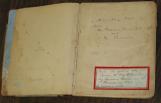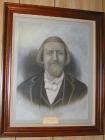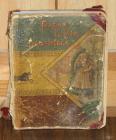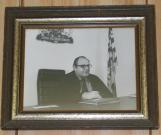1
Past Residents of YaleThe number of men and women born in Yale, or moved to Yale, is a significant number as she was once said to be the largest city north of San Francisco and west of Chicago. Most of these past residents moved on, though some opted to stay. Many of those that left held such a fondness for the old town that they requested their bodies be brought back to Yale and buried in the cemetery. All that once walked her streets left their impression on the town as she did on them.
Enough cannot be said of the great contributions these pioneers made to Yale and the province of British Columbia
3
Ned Stout1824-1924
An Enduring Pioneer Family
The patriarch of the Barry family was Edward (Ned) Stout, born in Germany September 24th, 1924, and naturalized in British Columbia in 1858. 1 Ned was involved in the Fraser Canyon War the summer of 1858, and took an arrow in the arm. That arrowhead still exists in the collection of a member of the Chrane family. As well, Bernice Plante, an artifact collector, recently donated his Smith & Wesson six-shooter handgun to the Yale Museum.
Ned Stout is quite famous in Barkerville, where Stout's Gulch still bears his name. The Gulch was where he staked his gold claim, and presently a sign on the road to Barkerville points the way there.
In Richard Thomas Wright's book "Barkerville: William's Creek, Cariboo", he writes, "Edward (Ned) Stout was a California '49er. Born in Bavaria, he was working with his uncle on a Lake Michigan steamer when gold lured him to California, and, in 1858, to the Fraser River. He came north to Bellingham, Washington Territory, and built two flat boats for the trip to Yale, which he reached in May, 1858. At China Bar he and his party were attacked by Indians. Stout, wounded by nine arrows, was the sole survivor.
After recovering from his wounds, he walked to the Cariboo in 1860 and was near Dutch Bill Dietz when gold was found on Williams Creek. Stout's claim did not prove up, so he and two partners staked claims in the valley or gulch running in from the west. Their success encouraged men like Barker to try below the canyon for placer gold.
After mining interest waned, Ned Stout worked as a packer, then moved to Yale. In 1873 he married Mary Thorpe of Yakima, Washington, and had three children. He is buried in Yale." 2
The Fraser Canyon War was caused by the cavalier attitude of the miners toward the local aboriginal people, particularly the women. Ned Stout was in one of the four parties that rallied in Yale and marched up the Canyon to deal with the 'insurrection'. Dan Marshal of Cobble Hill, Vancouver Island, B.C. wrote an interesting paper on the subject.
Ned Stout's wife was Mary Matilda Thorp (1851-1880), the daughter of Margaret Bounds and Fielding Mortimer Thorp of Ellensberg, Washington. Fielding was the son of John Thorp. Ned and Mary had three daughters, Margaret Helen, Mary Ellen, and Daisy. The background of the Thorps is not known at this time, but it is believed that Mary Matilda was of aboriginal lineage.
According to the Barry oral history, Mary Thorp was killed in a raid in 1880, possibly by her own relations. 3 Rumor has it that her people were not pleased she had married a European man.
After his wife was killed, Stout took his daughters with him back up to Yale.
Mary Ellen Stout (1876-1972), born March 29th, 1876, 4 remained in Yale with her father. Both the 1891 and 1901 Censuses record just the father and daughter as one family in Yale.
At the age of 29, Mary Ellen Stout married 5 Charles Barry (1862-1924), an Ontarian of Irish heritage, born August 8th, 1862. 6 They had one son, Charles Edward Barry (1905-1974), who became a Provincial Court Judge.
1- 1901 British Columbia Census
2- Wright, Richard Thomas. Barkerville, Williams Creek, Cariboo: A Gold Rush Experience. Williams Lake, B.C.: Winter Quarters Press, 1998. p. 120
3- Personal communication by Maurine Barry, 2003
4- 1901 British Columbia Census, Yale
5- BCVS
6- 1901 British Columbia Census, North Bend
7
The Barry FamilyThe Barry family has been in Yale since the days of the 1858 Gold Rush. They have been storekeepers for generations, during the 1930s to 50s they owned and operated the local Red & White Store, and are still running Barry's Trading Post. Adjoining the present market is the newest old store, a little Panabode log building where everyone in the area shopped for all their needs. Built in 1954 after the old Red & White burned down, for the past twenty-odd years it has been used for storage.
Mary Ellen Stout (1876-1972), born March 29th, 1876, 6 lived in Yale with her father, Ned Stout. Both the 1891 and 1901 Censuses record just the father and daughter as one family in Yale, due to the marriages of her older sisters and the murder of her mother.
The Barry family owns a wonderful artifact. It is a children's book given to his great-grandmother during a visit by Queen Victoria's daughter, Princess Louisa, and the Governor-General. The book is called "Papa's Little Daughters" by Mrs. Mary D. Brine, Cassell, Petter & Gilpin, 1882. The inscription reads "To Miss Mary Stout, from Governor-General and the Princess."7
At the age of 29, Mary Ellen Stout married 8 Charles Barry (1862-1924), an Ontarian of Irish heritage, born August 8th, 1862. 9 They had one son, Charles Edward Barry (1905-1974), who became a Provincial Court Judge. C.E. Barry married Lily Merle Dennis of Agassiz, formerly of Stewiacke, Nova Scotia (died in 1986), whose genealogy is recorded in "The Dennis Saga".
Lily and Judge C.E. Barry had two sons, William (Bill) Barry and Robert (Bob) Barry. Bill married Diane, and had a son Cyril. They reside in Maple Ridge. Bob married Maurine, and they had three children, Robert Bruce, Maurice, and Catherine.
6 1901 British Columbia Census, Yale
7 Visit of Princess Louise and her husband, the Governor-General, Duke of Argyll, see Appendices
8 BCVS
9 1901 British Columbia Census, North Bend
9
Dedication to Mary Ellen Stout from Princess Louisa and Governor General of Canada, Marquis of Lorne1882
Yale B.C.

11
Judge Charles Edward Barry1905-1974
At the age of 29, Mary Ellen Stout married Charles Barry (1862-1924), an Ontarian of Irish heritage, born August 8th, 1862.
They had one son, Charles Edward Barry, who became a Provincial Court Judge. He served the communities of Hope and Yale for many years, and in his honour a new school was named for him in Hope, B.C. The C.E. Barry Junior Secondary School opened in September, 1973, serving Grades 7 and 8. It later became the C.E. Barry Elementary School, teaching Grades 5 to 7.
C.E. Barry married Lily Merle Dennis of Agassiz, formerly of Stewiacke, Nova Scotia. whose genealogy is recorded in "The Dennis Saga". Lily Barry died in 1986.
Lily and Judge C.E. Barry had two sons, William (Bill) Barry and Robert (Bob) Barry. Bill married Diane, and had a son Cyril. They reside in Maple Ridge. Bob married Maurine, and they had three children, Robert Bruce, Maurice, and Catherine.
12
The Castle Family1858 - 2004
Pioneers with a Deeply-Rooted Aboriginal History, Bakers, Merchants, Railroaders, Prospectors
The Castle Family has an amazing and convoluted history. The patriarch known to everyone is August Castle, who had 4 wives, 11 children of his own, plus 5 more adopted children from his wives' previous marriages. Everyone in his family; including his mother, was of aboriginal ancestry, except his father. The Historic Yale Museum is based in the Castle family home, so if you feel any ghosts, they are likely the Castles.
August Castle lived through tragedy and triumph during his 104 years. Both his mother and his daughter were taken from him in murder-suicides, and he lost another son to drowning. He was both a pioneer and an indigenous person, living his life with prospecting, packing, mining, railroad construction, and law-based jobs.
13
The Murder-Suicide of Martin Castle, SeniorWe must start with August's father, the first patriarch of the Castle family. No one knows when Martin Castle Senior came from England to British Columbia, but he is sometimes referred to as the first baker in Victoria. Apparently he had three bakeries in the city; the first at Craigflower Manor Farm. 1 The second bakery was on Johnson Street 2 and a possible third is the Chelsea Bakery & Store, street unknown, proprietor written as Marvin Costello. 3 Handwritten records being what they were at the time, his name is variously recorded as Castle, Castel, Cassell, and possibly Costello.
The English immigrant baker known as Martin Castle, fell in love with and married an Esquimalt woman of the Cowichan Tribe. 4 Her name is also hard to define; the records have her as Janet or Jinnie, and even Mary, with a family name of either Eitess or Eitau. We will call her Janet, the most common reference.
Martin married Janet sometime before 1862. They had five children; Michel, Martin, August, Alfred, and Ellen Isabel. We know that Martin Junior had a job as a waiter on the sternwheelers that traveled between New Westminster and Yale.
At some point in their lives there appears to have been some kind of a scandal that affected the family. Martin Sr. reacted in a terrible way. He murdered his wife, set fire to all three of his bakeries, and then committed suicide.
Poor August was only about 13 years old at the time. He had to go and live with his brother, Martin Jr., the steamboat waiter that lived in New Westminster. Eventually Michel, Martin and August moved to Yale, likely because of the work opportunities. Michel married Monica Silweltow, a native resident of Yale, in 1885. Nothing else is known of them at this time.
1 B.C. Archives, Call #
2 First Victoria Directory, BC Archives
3 Victoria Directory
4 Description by family member






